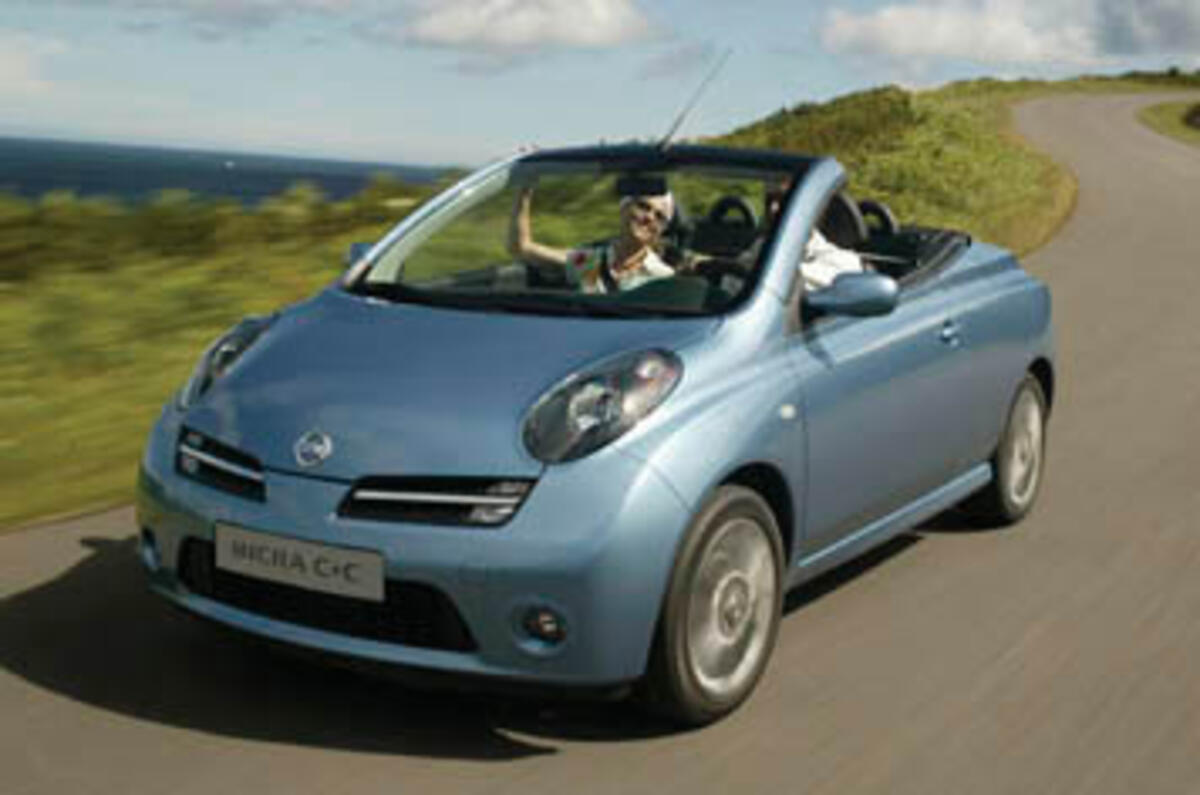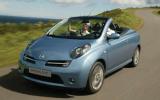Who said the British car industry was dead? For nine years, a plant in the north-east of England has been Europe’s most efficient car factory, and the next car to roll down its production line counts as a major success for Blighty, too. That’s because this Nissan Micra C+C was designed in London, engineered in Cranfield (with a little help from Osnabrück in Germany) and built in Sunderland.The C+C has been a long time coming – the concept car was previewed at the Paris motor show back in 2002, and the car you see here appears largely unchanged. But look closer and you’ll see crucial differences, most exciting being the ‘C-View’ glass folding roof, which replaces the concept’s metal lid. The roof is the work of German coachbuilder Karmann, the people behind Renault’s glass-topped Mégane. Another class first is the roof’s one-touch operation, with no need to undo any latches or push/pull the roof edge.In taking its time, Nissan has worked hard on ironing out the problems usually associated with baby coupé-cabrios, namely reliability (see panel, right) and practicality. Learning from disappointing sales of the two-seat Vauxhall Tigra, Nissan has opted for a Peugeot 206 CC-style 2+2.Like the Peugeot’s, the Micra’s upright rear seats are only realistically usable by children for anything other than short journeys. And for boot space, the Nissan not only leads the drop-top supermini class, but also embarrasses plenty cars from the class above. At 457 litres with the roof up and 255 litres with the lid stowed, the Micra trounces the Peugeot 307 CC’s 350/204-litre load bay – you can even squeeze a suitcase through the gap left between the folded roof and the sill.Whether you’re playing poseur or load-carrier, the Micra looks sharp with a neat coupé profile roof-up and slightly squat roadster outline with it dropped. The C+C lacks the Tigra’s aggression, but with 65 per cent of buyers expected to be female, Nissan reckons the cutesy look is what’s needed.First surprise from behind the wheel is that the C-View roof isn’t just a gimmick. Not only does the cabin feel spacious and bright, but with the roof up it sounds less tinny inside than rivals do and doesn’t have the terrible blind spots that blight the Tigra or Mini Convertible.Press a button between the front seats and 22sec later the roof has neatly stowed beneath the rear-hinged boot. Taller drivers, though, will be confronted with the familiar oppressively-close windscreen header, despite a 14mm-lower driver’s seat than in the hatch, but at least the cabin remains largely free from buffeting – even at motorway speeds with the windows down.With the 108bhp 1.6-litre four-cylinder from the 160SR, those high speeds are reasonably easy to attain, and once there it feels impressively stable. As in the hatch, it’s a perky engine that enjoys being revved, though the extra 126kg of the C+C makes it feel a bit stagnant in higher gears.Like the hatch, the C+C is a characterful little car. The speed-sensitive steering is electrically assisted and feels artificial, but it’s accurate. Combined with the positive five-speed gearchange, it makes the Micra feel eager along sinuous roads. There’s decent grip from the 185/50 tyres (160SR refugees, along with the alloys), but when pushed the C+C washes into understeer. It’ll tighten its line if you come off the throttle, but it lacks the 206 CC’s playful edge.Hit a bumpy road, though, and the Nissan demonstrates what an extra few years of development can do for structural integrity. We’ll have to wait to see how it gets on in the UK, but on our Portugese test route the Micra feels like the most rigid drop-top supermini yet.The MacPherson strut front/torsion beam rear suspension mates decent body control with a compliant ride, and though a cobbled street did make the screen frame shake, under most conditions the C+C felt commendably unflustered.In the transition from hatch to cabrio, the A-pillars and sills have been strengthened, there are new cross-members under the floor and dash, plus bracing behind the rear seats and beneath the rear floor. Nissan has also added a weight in the boot to act as an acoustic damper to counteract scuttle shake. Raise the roof and it feels stiffer still, with none of the creaks and rattles you can’t get in the Mini.An appealing package, then, and that’s before you take economics into account. The entry-level C+C is the £13,150 Urbis, powered by an 87bhp 1.4. But it’s unlikely to get many takers when just £845 more buys this 108bhp 1.6 Sport, which adds air-conditioning (a £500 option for the 1.4), 16-inch alloys and sporty-looking trim.Standard kit includes anti-lock brakes with EBD, four airbags, an excellent six-speaker CD player, electric windows and mirrors and sports seats. It’s cheap to insure (group five for the 1.4 and group six for the 1.6) and Nissan claims over 40mpg for both engines, with a diesel expected in 2007.A coupé-cabrio without the compromises – what better reason do you need to buy British?Alastair Clements
Fine Micra packaging and generous kit should worry class leaders
Close
Back to top

























Add your comment